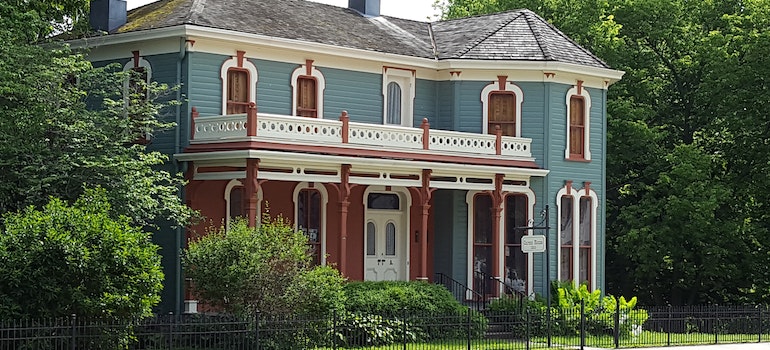Relocating between the coasts is not just a geographic transition, but a passage between two realms with distinct climatic patterns, cultural landscapes, and market dynamics. By embarking on this venture with well-rounded knowledge and preparation, you not only facilitate a smooth move but also transition seamlessly into a new chapter of life. In this article, Verified Movers will explore the vital considerations for moving from West Coast to East Coast, thus helping you prepare for the long journey ahead, so stay tuned.
Logistics and Planning For a Coast-to-Coast Move
One of the cornerstones of a successful move is selecting a seasoned moving company with expertise in interstate relocations. Ensure they are insured to safeguard your valuables during the transit. A smooth relocation is also contingent upon adhering to the regulatory frameworks, encompassing various federal and local council laws, and obtaining necessary permits. Prepare yourself by researching and understanding these nuances, setting a foundation for a seamless move.

Popular moving routes and costs of those relocations
Relocating from the West Coast to the East Coast entails traversing some considerable distances and popular routes. It’s important to note that moving costs can vary significantly based on a multitude of factors including the volume of your belongings, the time of year, and the specific services you choose. Below, we’ll highlight some popular routes and give you an estimation of the costs involved if you decide to hire a team of moving professionals to assist you on this journey, which is certainly highly recommended. Just bear in mind that we’ll only mention the rough estimates in the manner of price ranges and that you should contact the company of your choice for a free quote in order to obtain a more accurate price.
Los Angeles, CA to New York City, NY
- Route: I-40 E – covering approximately 2,800 miles
- Average Cost: Easily one of the most popular routes in the nation and the one that best LA movers know by heart. Moving a three-bedroom house to NYC from LA can cost between $4,000 to $10,000 depending on various factors including the moving service level and the exact locations of departure and arrival.
San Francisco, CA to Washington, DC
- Route: I-80 E – spanning around 2,800 miles
- Average Cost: For a standard three-bedroom home, you are looking at costs ranging from $4,500 to $11,000.
Seattle, WA to Boston, MA
- Route: I-90 E – roughly about 3,000 miles
- Average Cost: Thinking of leaving the Emerald City with top movers Seattle? If Boston is your choice, know that moving a three-bedroom house from WA to MA generally falls in the price range of $5,000 to $12,000.
San Diego, CA to Miami, FL
- Route: I-10 E – approximately 2,660 miles long
- Average Cost: A big number of people who are moving from West Coast to East Coast are actually moving down this route. San Diegans love Miami. If you’re among those considering this relocation, the typical cost for moving a three-bedroom home can be between $4,500 to $10,500.
Portland, OR to Philadelphia, PA
- Route: I-84 E and I-80 E – spanning slightly less than 3,000 miles
- Average Cost: Expect to pay somewhere between $4,500 to $11,000 for the services of cross country movers Portland in order to relocate a standard three-bedroom house all the way to Philadelphia.
There were some of the most popular routes, and as you can see, the distances between them are quite similar, and so is the cost. Therefore, you can expect a similar price range for other popular routes, for example, relocations to cities like Atlanta, Charlotte, Baltimore, Tampa, as well as many other gems on the East that we haven’t mentioned above.
Understanding the Housing Market
The first noticeable difference in East Coast vs West Coast comparison is housing. Diving into the East Coast housing market requires a careful analysis of the prevalent trends and pricing dynamics. The shift from the West to the East Coast often involves navigating a different spectrum of housing prices and neighborhood vibes. After the move, quickly setting up your utilities can aid in a smooth transition to your new abode. Moreover, integrating into the community through active participation in neighborhood activities can foster a quicker settlement process.

The U.S. housing market, with its vast expanse and diverse regions, showcases significant contrasts between the East Coast and West Coast. Both coasts boast major cities, but they each offer unique opportunities, challenges, and trends. Here’s a deeper look into the disparities:
Are there any differences in prices?
Traditionally, West Coast cities like San Francisco, Los Angeles, and Seattle have seen skyrocketing home prices, driven by the tech boom, limited space for expansion, and high demand. San Francisco, for instance, is notoriously one of the most expensive cities in the U.S., with median home prices often surpassing $1M. Therefore, if you’re moving with the best San Francisco movers from this city to the East Coast, as well as from any other West Coast major metro area, in most cases you should expect significantly lower housing prices.
The East Coast features a wider range of pricing. New York City, especially Manhattan, can rival or even surpass San Francisco’s prices. However, cities like Atlanta or Charlotte offer much more affordable options, with median home prices often ranging from $250,000 to $400,000. So, as we said, usually the prices are lower, but East Coast also has some pricey options and it will all depend on your preferences regarding destination.
Type and age of housing
Housing on the West Coast tends to be newer, reflecting the area’s population boom in the 20th century. For example, sprawling suburbs of Los Angeles or San Diego often feature mid-century ranch-style homes. So, for those of you who are moving with San Diego top movers from Californian suburbs, prepare to experience a significant change in the structure of homes. The East Coast has a rich historical tapestry, and its housing stock reflects that. Certainly, the difference to Californian cities, as well as most others from the West Coast, is quite noticeable. Cities like Boston, Philadelphia, and Charleston boast colonial, Georgian, and Victorian homes that date back centuries.

Land & Space
Due to geographic constraints like mountains and oceans, West Coast cities often face limitations on sprawl. This has led to higher densities, vertical living (e.g., condos and townhouses), and smaller property sizes in cities like Seattle or San Francisco. While major cities like NYC also prioritize vertical living, other parts of the East Coast, such as the suburbs of Atlanta or Washington D.C., tend to have larger plots of land and more sprawling homes.
Market dynamics
The tech industry’s explosive growth has transformed the housing market on the West Coast, especially in areas surrounding tech hubs like Silicon Valley. The influx of high-salary tech jobs has increased demand and driven prices up. On the other hand, after moving from West Coast to East Coast, you’ll see that the market on the East Coast is influenced by a diverse set of industries including finance in NYC, politics in D.C., and education in Boston. This results in a more heterogeneous housing market with various factors driving demand.
Climate Adjustments After Moving From West Coast to East Coast
Moving to the East Coast necessitates preparations for a more distinct four-season cycle compared to the West Coast. Develop a contingency plan for extreme weather conditions, which can be a new experience if you are accustomed to the milder climate of the West Coast. Additionally, you might find that making adjustments to your new home, such as enhancing insulation and weather-proofing measures, can offer a comfortable living environment irrespective of the season.

Moving from the generally warm and dry climate of the West Coast to the more seasonally varied and humid environment of the East Coast involves considerable adjustments. Here are some factors to keep in mind:
Seasonal variations
The West Coast predominantly features mild winters and dry summers, especially in areas like Southern California. Northern regions, such as Seattle, experience more rainfall and somewhat cooler temperatures. On the contrary, the East Coast offers a pronounced four-season cycle, with cold winters and hot summers. Coastal areas might experience milder winters compared to regions situated inland.
Humidity levels
The coastal areas of the West Coast tend to have relatively lower humidity, resulting in drier conditions, which can be more comfortable for many people. East Coast generally presents higher humidity levels, which can make the summers feel hotter and the winters feel colder due to the wind chill factor.
Preparation for extreme weather events
West Coast residents are more accustomed to preparing for earthquakes and wildfires. Hence, moving from West Coast to East Coast will involve a paradigm shift in emergency preparedness. This is because the East Coast residents must brace themselves for a different set of extreme weather conditions including hurricanes, nor’easters, and blizzards. Setting up an emergency plan for these eventualities is recommended.

Home adjustments
Western homes are generally designed to keep cool, utilizing features like tile flooring and central air conditioning. This is natural considering the warm and often very dry conditions people on this side of the US are facing. Now, what you need to know before you make a move is that, on the East Coast, it is crucial to ensure homes are equipped to handle both hot and cold extremes. Insulating homes properly, installing energy-efficient windows, and setting up high-quality heating and cooling systems will be beneficial.
Cultural integration
Relocating to the East Coast is a gateway to immerse yourself in a region steeped in history and cultural diversity. Enrich your experience by delving into the historical background of your new locale and actively participating in local festivities. Cultivating local networks and community engagements can pave the way for a rich and fulfilling life on the East Coast, allowing for a smooth transition and nurturing a deep sense of belonging. If you’re moving with the family, there’s also nothing to be afraid of. There’s a plethora of great places for families on the East Coast where you can make the most of life with your loved ones.
If you have the intention of pursuing your education after moving, we have some good news for you. Although you’re probably aware of that fact, there are some exceptional colleges on the East Coast. Not only they are great, but they are recognized across the world as one of the best educational institutions. You can expect more of the same for elementary schools and high schools as many states and cities on the East Coast are showing amazing results in terms of quality of education.
East Coast Adventure Awaits!
The journey of moving from West Coast to East Coast is an exhilarating one, laden with new opportunities and experiences. By paying heed to the aspects outlined above – from choosing the right moving company to embracing the rich cultural diversity of the East Coast – you are not just moving homes but transitioning into a new, exciting chapter of your life, armed with preparation and foresight. While our overall guide has certainly helped you understand what to expect in general, once you know the exact city you’re moving to, it will become much easier to plan. Once that happens, make sure to check out our blog as you will most certainly find a guide on moving from the city you call home now to the place you want to relocate. Until then, we wish you the best of luck and a safe move!




